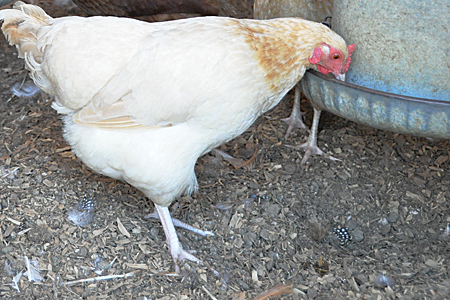
How much feed a chicken eats each week varies with the chicken’s age, breed, and strain, degree of activity, and condition of health. Other factors include the ration’s palatability and texture, and its energy and protein content.
In cold weather, a chicken stays warm by eating more than it does during the heat of summer. Free range chickens may seem to eat less if they are able to forage for part of their nutritional needs. Wasted feed, or a feeder offering access to rodents and birds, may give the appearance that chickens are eating more than their fair share.
So the answer to “How much feed does a chicken eat?” is essentially an estimated average.
To estimate how much feed a flock of mature chickens will eat in a week, multiply the following averages by the number of birds in the flock.
- A bantam chicken eats about ½ pound of feed per week.
- A light chicken breed eats 1½ to 2 pounds of feed per week.
- A heritage breed (dual purpose) eats 2½ to 3 pounds of feed per week.
- A heavy breed chicken eats 3½ to 4 pounds of feed per week.
Estimates for other types of mature poultry:
- A game bird eats 1 to 1½ pounds of feed per week.
- A duck eats 2½ to 3 pounds of feed per week.
- A goose eats 3 to 3 ½ pounds of feed per week.
- A turkey eats 4 to 5 pounds of feed per week.
The amount a chick eats keeps changing as the bird grows. Estimates for a growing bird are based on the growth period. Here’s how much you can expect to feed baby chicks:
- A layer chick eats 20 pounds of feed in the first 20 weeks.
- A Cornish-cross broiler eats 10 pounds of feed in the first 6 weeks.
- A game bird eats about 9 pounds of feed in the first 8 weeks.
- A duck eats 22 pounds of feed in the first 8 weeks.
- A goose eats 53 pounds of feed in the first 8 weeks.
- A turkey eats 72 pounds of feed in the first 12 weeks.
When estimating how much feed you’ll need between trips to the farm store, get only as much as you will use within about 6 weeks of manufacture, since aging feed loses nutritional value. Store the feed in such a way that it won’t go rancid, moldy, or stale. Rations keep best when stored in a cool, dry place, away from direct sunlight. Once you open a bag of feed, transfer the contents to a sealed container that keeps out insects and rodents.
And that’s today’s news from the Cackle Coop.
Gail Damerow, author, Storey’s Guide to Raising Chickens

